Don’t leave home with without the essentials!
Oh, boy, do I have a story for you! Picture this: It’s 2:00am, I’m in the middle of the Scottish Highlands, and I’ve just realised I forgot to pack a can opener.
There I am, staring at a bag full of canned goods, my stomach growling louder than the nocturnal critters around me. Talk about a rookie mistake!
But here’s the kicker – I’m not alone in my forgetfulness. Did you know that a whopping 77% of campers forget at least one essential item on their trips? Yep, more than three-quarters of us have experienced that facepalm moment when we realise we’ve left something crucial behind.
But don’t worry – I’m here to make sure you don’t join that statistic!
Welcome to your ultimate camping gear checklist for 2024. Trust me, after years of trial and error (and one particularly memorable can-opener incident), I’ve learned a thing or two about what you really need for a successful camping trip. This guide isn’t just a list – it’s your ticket to a safe, comfortable, and enjoyable outdoor adventure.
Whether you’re a seasoned backcountry expert or a first-time camper, this checklist has got your back. We’ll cover everything from the basics like shelter and sleep systems to those easily forgotten items that can make or break your trip.
And hey, I’ll even throw in some personal tips and tricks I’ve picked up along the way.
So grab a cup of coffee (or hot cocoa if that’s more your style), and let’s dive in. By the time we’re done, you’ll be so well-prepared for your next camping trip that you’ll be the envy of the campground. No more midnight can-opener disasters for you!
Table of Contents
Pack These Core Essentials or Stay at Home!
Master Your Camp Kitchen: Cook Like a Pro in the Wild
Dress for Success: Clothing That Keeps You Comfy and Safe
Be a Camp MacGyver: Tools That Save the Day
Stay Alive Out There: Crucial Safety Gear You Can’t Ignore
Amp Up the Fun: Comfort Items That Make Camping Awesome
Camp Green: Protect Nature While You Enjoy It
Your Camping Gear Shopping List: Don’t Forget the Essentials!
Time to Hit the Trail: Your Adventure Awaits!
Pack These Core Essentials or Stay at Home!
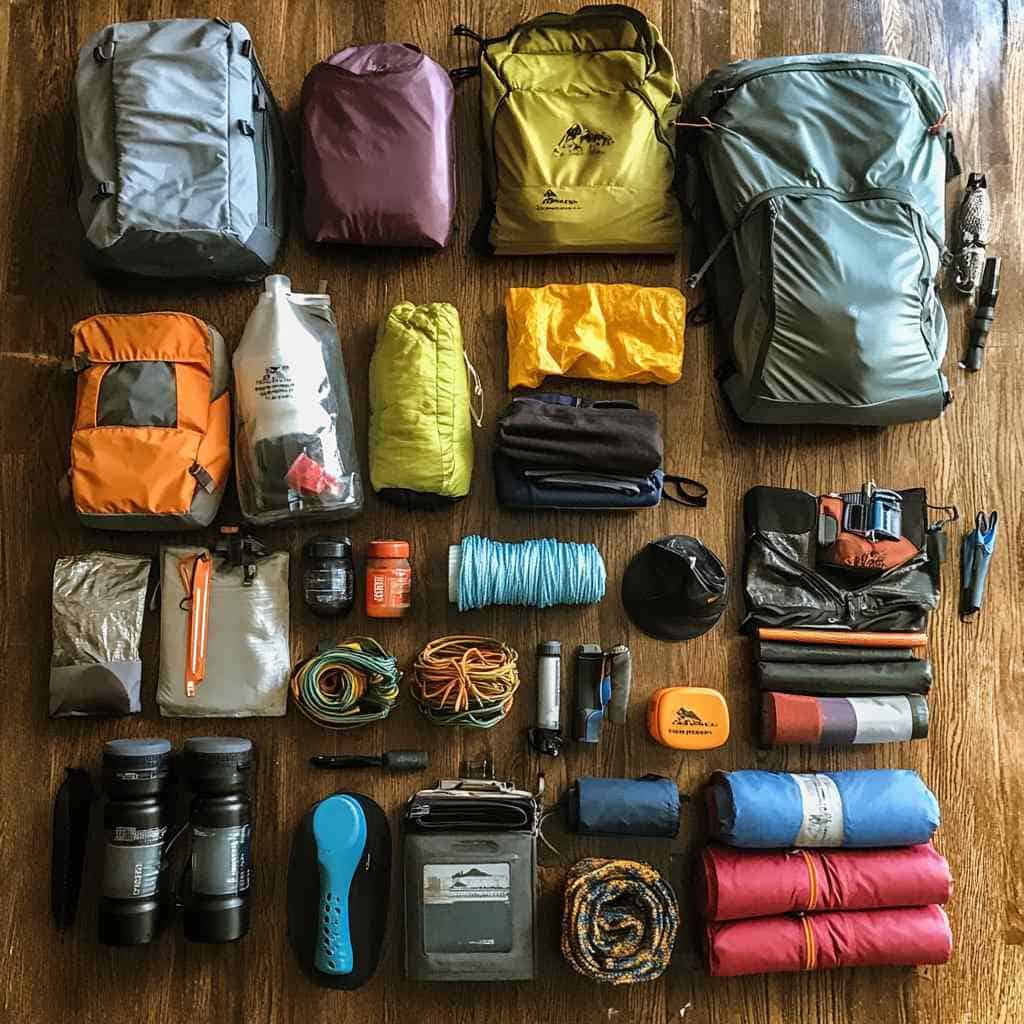
Alright, folks, let’s talk about the bread and butter of camping – the core essentials. These are the items that, if you forget ‘em, you might as well pack up and head home. Trust me, I’ve learned this the hard way!
First up, shelter. Now, I don’t know about you, but I’m not keen on sleeping under the stars every night (especially when it’s raining!). Your options here are pretty straightforward, but let me tell you, a good camping tent is worth its weight in gold.
I remember this one time in the Lake District when a sudden storm hit. My trusty four-season tent stood firm while my buddy’s cheap popup looked like it was auditioning for ‘Gone with the Wind’! So yes, invest in a quality tent, folks. Your dry, happy self will thank you later.
Your options here are pretty straightforward:
- Tent: The classic choice. Make sure it’s appropriate for the season and number of people.
- Tarp: For the minimalists out there. I’ve used this setup, and let me tell you, it’s liberating…until the mosquitoes find you!
- Hammock: My personal favourite for solo trips. There’s nothing quite like gently swaying in the breeze…just don’t forget the bug net!
Next, let’s talk about sleeping gear. You know what they say – a good day in the wilderness starts with a good night’s sleep. Here’s what you need:
- Sleeping bag: Choose one rated for the temperatures you’ll face. I once brought a summer bag on an Autumn trip…brrr!
- Sleeping pad: This isn’t just for comfort, folks. It insulates you from the cold ground.
- Pillows: Optional, but oh-so-nice. I use a stuff sack filled with clothes, but hey, each their own!
Lighting is crucial unless you want to go to bed when the sun does (been there, not fun!). Pack a headlamp for hands-free operation, a lantern for ambient light in your tent or campsite, and a flashlight as a backup. Pro tip: always bring extra batteries!
Navigation tools are non-negotiable, even if you think you know the area like the back of your hand. Trust me, everything looks different in the dark or fog! Bring a map, compass, and maybe a GPS device. And please, learn how to use them before you go!
Lastly, don’t forget a first-aid kit. It’s one of those things you hope you never need, but you’ll be glad you have when you do. I once had to bandage a nasty cut miles from civilisation – that little kit was a lifesaver!
Remember, folks, these are just the bare bones. Depending on your trip, you might need more. But with these essentials, you’re off to a solid start.
Now, who’s ready to talk about camp kitchen gear? I promise, no more can-opener stories…maybe.
Master Your Camp Kitchen: Cook Like a Pro in the Wild
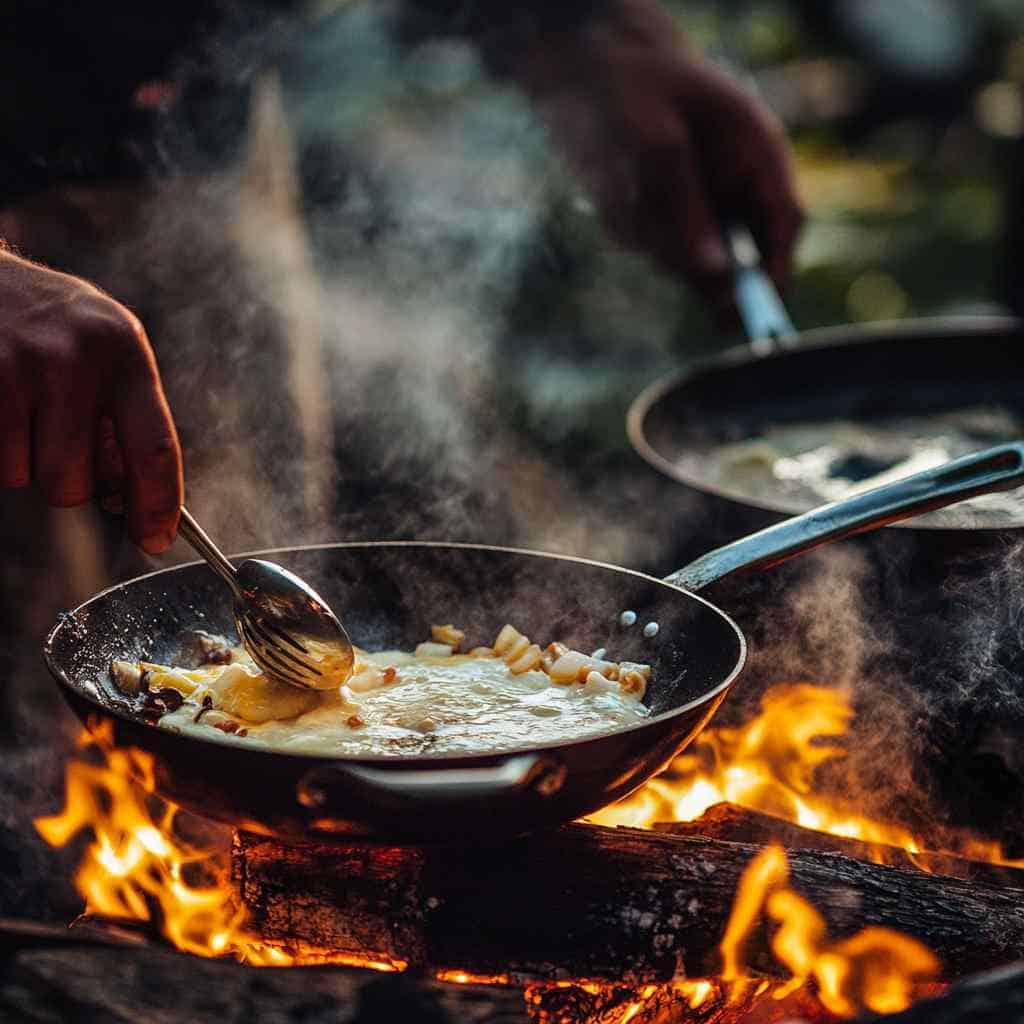
Alright, campers, let’s talk grub and camping cooking equipment! Because let’s face it, after a long day of hiking or paddling, nothing beats a hot meal around the campfire. And trust me, with the right gear, you can whip up some pretty impressive dishes in the great outdoors.
You don’t need to bring your entire kitchen, but a few key pieces can turn you into a regular campsite chef.
My go-to setup includes a compact cookset, a folding spatula, and spoon, and a good knife.
Oh, and don’t forget a collapsible water container – it’s a game-changer for dishwashing and cooking. With this setup, I’ve whipped up everything from pancakes to stir-fries. Who says camping food has to be boring?
First things first, you’re gonna need a stove.
Camp stoves, let me tell you, have come a long way since the days of lugging around a mini furnace. These days, you can find stoves that’ll boil water faster than your kettle at home, and they pack down smaller than a sandwich.
I’ve got a little single-burner that’s been my loyal companion on countless trips. Just remember, whatever stove you choose, practice using it at home first.
Trust me, trying to figure out how to light the darn thing when you’re cold, tired, and hungry isn’t a fun camping memory!
Now, I’m a big fan of compact canister stoves for backpacking trips. They’re lightweight, easy to use, and boil water faster than you can say “freeze-dried meals.”
But if you’re car camping, don’t be afraid to go big with a two-burner propane stove. Just don’t forget the fuel!
Next up, cookware. I learned the hard way that your kitchen pots and pans aren’t ideal for camping (sorry, Mum!).
Invest in a good camping cookset – lightweight, durable, and easy to clean. And speaking of cleaning, pack some biodegradable soap and a scrubber. Mother Nature will thank you!
Now, let’s talk about the most important camping resource – water. You’ll need a way to carry it and a way to purify it. I always bring a couple of large water jugs for car camping, or a hydration bladder for backpacking.
As for purification, I swear by my water filter. It’s saved me from some questionable-looking water sources!
Food storage is crucial, especially if you’re camping in bear country, in North America. A good cooler is worth its weight in gold for keeping perishables fresh. And don’t forget dry bags or bear canisters for your non-perishables. I once had a rats ransack my campsite – lesson learned!
Lastly, don’t forget your eating utensils. A plate, bowl, cup, and spork will cover most of your bases. I prefer reusable options to cut down on waste, but hey, no judgement if you go for disposables on shorter trips.
Oh, and one last pro tip: bring a small cutting board and a sharp knife. You’d be surprised how often these come in handy, whether you’re slicing cheese for your trail sandwiches or prepping veggies for your campfire stir-fry.
Remember, good food makes for happy campers. With these essentials, you’ll be the Gordon Ramsay of the campground in no time. Just try not to yell “It’s raw!” at your camping buddies, okay?
Dress for Success: Clothing That Keeps You Comfy and Safe
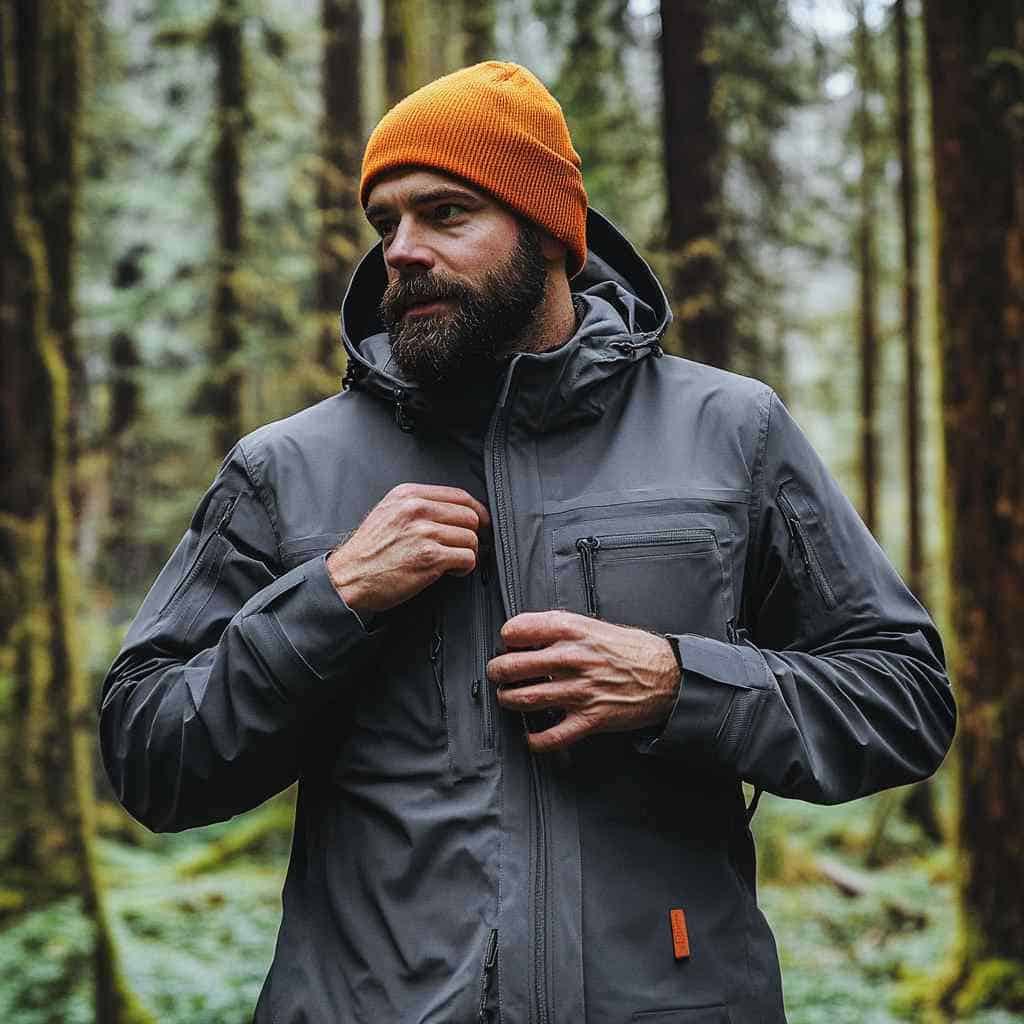
Let’s chat about clothes, shall we? Because nothing can ruin a camping trip faster than being uncomfortable in your own skin (or clothes, in this case).
First rule of camping fashion: layers, layers, layers! I can’t stress this enough. Mother Nature can be fickle, and you need to be prepared for anything she throws at you. Here’s my go-to setup:
- Base layer: Think moisture-wicking materials. Cotton is a no-go, folks. It holds onto sweat and can leave you chilled to the bone.
- Insulation layer: Fleece or wool are your best friends here. I’ve got a fleece jacket that’s seen more campfires than I can count.
- Outer layer: A good, waterproof, and breathable jacket is worth its weight in gold. Trust me, I learned this the hard way during a surprise downpour in the Rockies!
Don’t forget about your lower half! A pair of convertible pants (the ones that zip off into shorts) can be a real game-changer. And always, always pack extra socks. Your feet will thank you.
Now, let’s talk footwear. A good pair of hiking boots is essential if you’re hitting the trails. Break them in before your trip, unless you’re a fan of blisters (spoiler alert: you’re not).
And bring a pair of comfy camp shoes. Your feet deserve a break after a long day of adventuring!
Sun protection is crucial, even on cloudy days. A wide-brimmed hat, sunglasses, and sunscreen should be in every camper’s bag. I once underestimated the sun’s power on a cloudy day and ended up looking like a very unhappy lobster.
Personal hygiene might not be the most exciting topic, but it’s important. Biodegradable soap, toothbrush, and toothpaste, deodorant, and toilet paper are must-haves. And ladies, don’t forget any feminine hygiene products you might need.
Last but definitely not least, insect repellent. Unless you want to be the local mosquito buffet, that is. I prefer ones with DEET for serious protection, but there are natural alternatives if that’s more your style.
Remember, the key to happy camping is being comfortable. With these clothing and personal items, you’ll be ready for whatever adventure comes your way. Now, who’s ready to talk about tools and repairs? Because let me tell you, duct tape has saved my bacon more times than I can count!
Be a Camp MacGyver: Tools That Save the Day
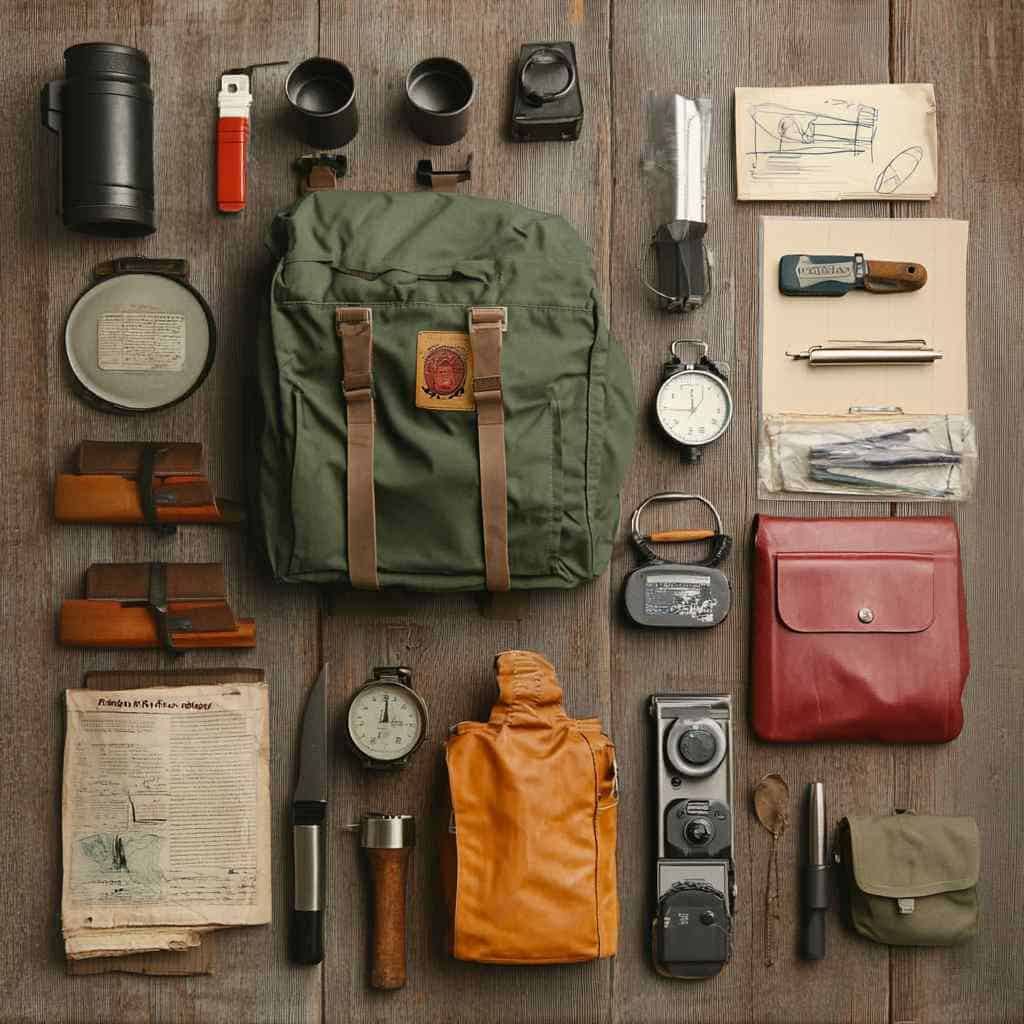
Alright, adventure seekers, let’s dive into the unsung heroes of any camping trip – tools and repair gear. Now, I know what you’re thinking: “Do I really need to lug around a toolbox in the wilderness?” Well, let me tell you a little story…
I’m on a week-long backpacking trip, miles from civilisation, when the sole of my hiking boot breaks. Panic mode, activated!
But then I remembered the little repair kit I’d packed. A bit of strong adhesive and some duct tape later, and I was back on the trail. Crisis averted!
So, what should you pack in your magical fix-it kit? Let’s break it down:
- Multi-tool or knife: This is your wilderness Swiss Army knife. I never leave home without my trusty multi-tool. It’s got pliers, a knife, screwdrivers, and even a can opener (no more midnight can crises for me!).
- Duct tape: The ultimate fixer-upper. I’ve used it to patch tents, repair gear, and even as an emergency bandage. Pro tip: Wrap some around your water bottle instead of bringing the whole roll.
- Paracord: This stuff is incredibly versatile. Use it for clotheslines, gear repairs, or even as emergency shoelaces. I once used it to rig up a makeshift clothesline after an unexpected river crossing. Dry socks are happy socks!
- Tent repair kit: A few patches and some seam sealer can be the difference between a dry night and a soggy disaster. Trust me, you don’t want to find out your tent has a leak in the middle of a downpour.
- Firestarter and matches: Even if you’re a wizard with friction fire starting, bring some backups. I like to bring both waterproof matches and a ferrocerium rod. Because when you need a fire, you really need a fire.
- Saw or axe: This depends on your camping style. For backpacking, a folding saw is usually sufficient. Car camping? A small axe can be handy for processing firewood.
Remember, the key here is to be prepared without overloading your pack. You don’t need to bring the whole hardware store!
One last pro tip: familiarise yourself with your gear before you hit the trail. Know how to use that multi-tool, practice with your firestarter, and make sure you can set up and take down your tent in your sleep. Because when the sun’s setting and you’re tired, hungry, and maybe a little lost, you’ll be glad you did.
Now, who’s ready to talk about safety gear? Because let me tell you, the wilderness is beautiful, but it demands respect. And a little preparation goes a long way in keeping your adventure fun and safe!
Stay Alive Out There: Crucial Safety Gear You Can’t Ignore
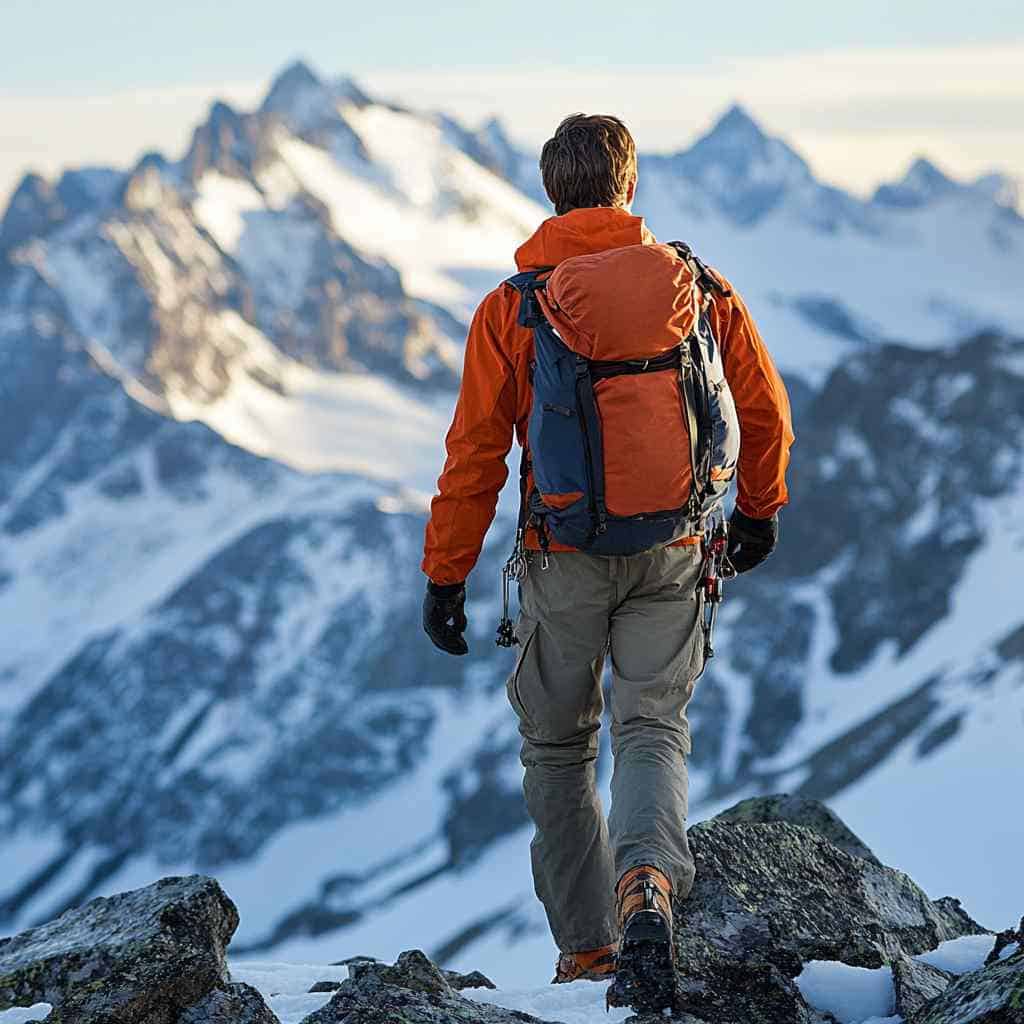
Well, let’s talk about safety and emergency gear. It’s not the most exciting topic, but it’s very important. Now, I know what some of you might be thinking: “I’m just going for a weekend in the woods, not scaling Everest!”
But trust me, Mother Nature doesn’t care if you’re on a quick overnight trip or a month-long expedition. She can throw curveballs at any time, and it’s up to us to be prepared.
Let me share a quick story. A few years back, I was on what was supposed to be an easy day hike. Beautiful weather, well-marked trail, the works.
But then fog rolled in, thick as pea soup, and suddenly that “easy” trail wasn’t so easy to follow. If I hadn’t had my emergency gear, well…let’s just say I’m glad I did.
So, what should you pack in your safety kit? Let’s break it down:
- Emergency shelter: A space blanket or emergency bivy bag. They’re lightweight, compact, and can be a lifesaver if you’re stuck out overnight unexpectedly. Mine has a nice crinkly sound that doubles as a bear deterrent! (Okay, maybe not, but it makes me feel better.)
- Whistle: Three blasts is the universal distress signal. It’s louder and lasts longer than yelling. Plus, it’s great for scaring away curious critters.
- Signal mirror: Can be used to signal rescue aircraft or catch the attention of distant hikers. Pro tip: practice using it before you need it. My first attempt looked more like a disco ball than a distress signal.
- Emergency communication device: A satellite messenger or personal locator beacon. Cell phones are great, but they don’t always have service in the backcountry. These devices can quite literally be lifelines.
- Bear spray: If you’re in bear country, this is a non-negotiable. And please, learn how to use it before you go! Spraying yourself instead of the bear is…not ideal. (Don’t ask me how I know this.)
Remember, the goal isn’t to scare you. It empowers you to handle whatever situation might arise. Because here’s the thing – the more prepared you are, the more you can relax and enjoy your adventure.
One last piece of advice: always let someone know where you’re going and when you plan to return. It’s a simple step that can make a huge difference if something goes wrong.
Now, who’s ready to lighten the mood a bit and talk about some fun stuff to bring camping? Because while safety is crucial, camping is all about enjoying nature and having a good time. And I’ve got some ideas that’ll make you the most popular person at the campfire!
Amp Up the Fun: Comfort Items That Make Camping Awesome
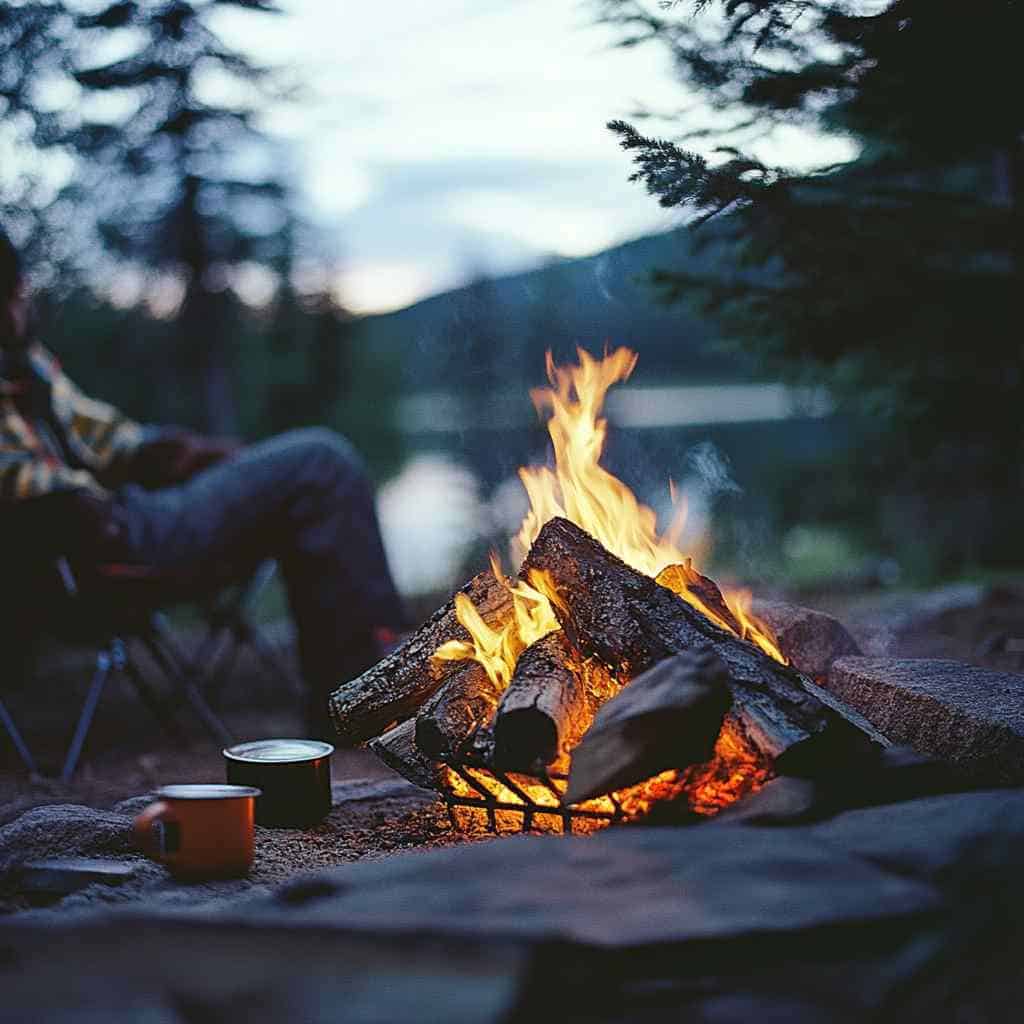
Alright, fellow nature enthusiasts, we’ve covered the serious stuff. Now let’s talk about the fun part – comfort and entertainment! Because let’s face it, while we all love the great outdoors, there’s nothing wrong with bringing along a few creature comforts to make your camping trip extra enjoyable.
First up, let’s talk seating. Now, I know some hardcore backpackers might scoff at the idea of bringing a chair, but after a long day of hiking, your backside will thank you. I’m a big fan of lightweight camping chairs.
They’re compact, easy to carry, and oh-so-comfy. If you want to save weight, even a simple foam sitting pad can help a lot when you’re sitting on a log or rock.
Now, let’s talk about getting a good night’s sleep in the great outdoors.
While some extreme campers might scoff at the idea, a comfortable camp bed can make all the difference between waking up refreshed and ready for adventure, or feeling like you’ve gone ten rounds with a grizzly.
I swear by my inflatable sleeping pad. It packs down small, weighs next to nothing, and keeps me comfy even on rocky ground.
And if you’re car camping? Don’t be afraid to go all out with an air bed. Your back will thank you!
Next, let’s discuss entertainment. Now, I know what you’re thinking – “Isn’t nature entertaining enough?” And sure, watching a sunset or gazing at the stars is pretty darn amazing.
But for those moments when you’re stuck in your tent waiting out a rainstorm, having a good book or an e-reader can be a real lifesaver. I always pack a paperback (pro tip: choose something lightweight but engaging).
Cards or travel-sized board games are another great option. I once spent a hilarious evening playing charades with my camping buddies during an unexpected thunderstorm. Let me tell you, trying to act out “fly fishing” in a cramped tent is quite the challenge!
If you’re into wildlife watching, a pair of binoculars can add a whole new dimension to your outdoor experience. I’ll never forget the time I spotted a family of otters playing in a lake – all thanks to my trusty binos.
For the musically inclined, a small instrument can be a great addition to your camping kit. I have a friend who always brings his harmonica. There’s something magical about sitting around a campfire, listening to a bit of music under the stars. Just maybe practice a bit before you subject your fellow campers to your rendition of “Kumbaya”, okay?
And speaking of campfires, don’t forget to check if they’re allowed where you’re camping. If they are, bringing along some marshmallows, chocolate, and graham crackers for s’mores is always a hit. There’s nothing quite like that gooey, chocolatey goodness to end a day of adventure.
Remember, the key is to find a balance between comfort and practicality. You don’t want to overload your pack with unnecessary items, but a few well-chosen comfort items can turn a good camping trip into a great one.
Now, who’s ready to talk about how we can enjoy all this while still being kind to Mother Nature? Because let me tell you, leaving no trace isn’t just a saying – it’s a way of life for us outdoor lovers!
Camp Green: Protect Nature While You Enjoy It
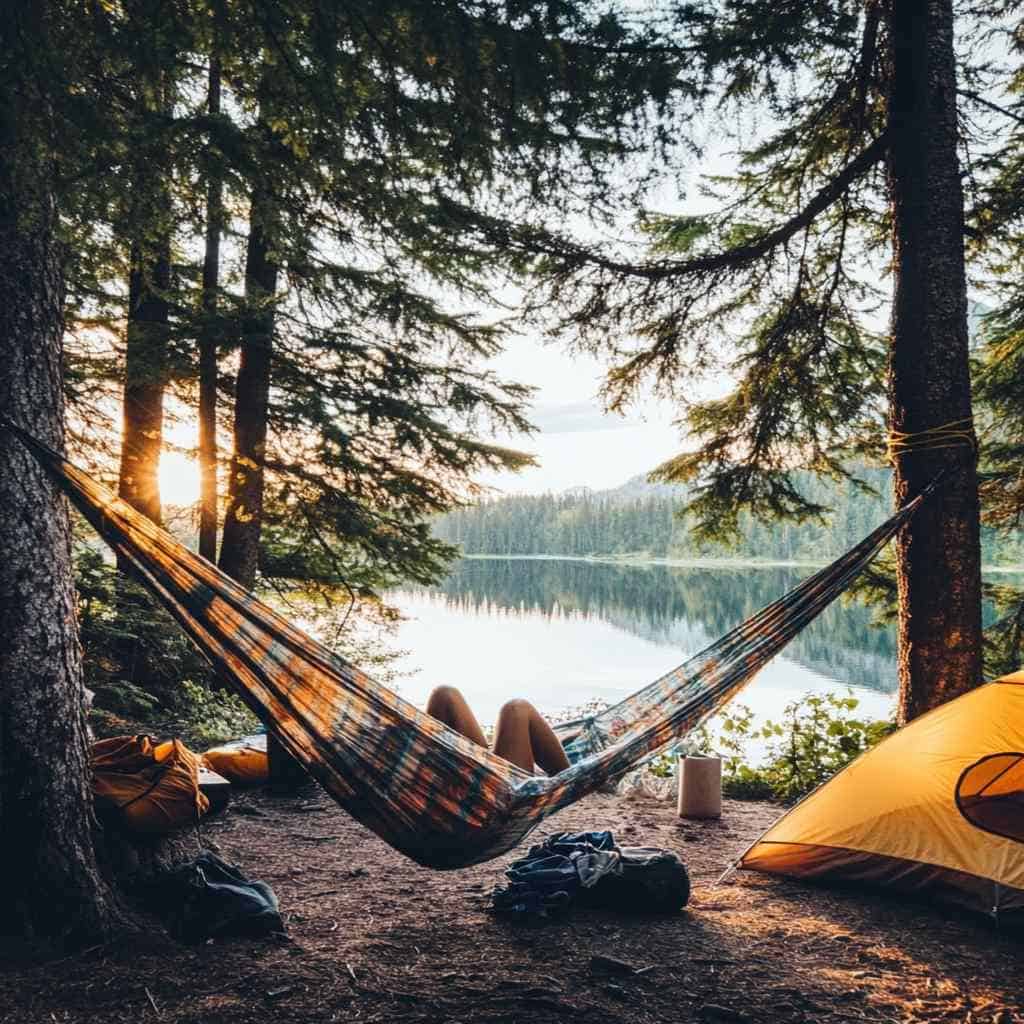
Alright, nature lovers, it’s time for us to have a heart-to-heart about keeping our outdoor playgrounds pristine. Because let’s face it, if we want to keep enjoying these beautiful spaces, we’ve got to do our part to protect them. And trust me, being an eco-friendly camper is easier than you might think!
First things first, let’s talk about the products we bring into the wilderness. I’m a big fan of biodegradable soap and toiletries.
I learned this lesson the hard way when I saw the suds from my “regular” shampoo floating down a crystal-clear stream. Talk about a wake-up call! Now, I always pack biodegradable options. They’re just as effective and much kinder to the environment.
Next up, let’s chat about water bottles and food containers. Reusable is the name of the game here, folks. I’ve got a trusty water bottle that’s been with me on more adventures than I can count.
And for food, I love using reusable containers. They’re great for packing in snacks and packing out trash. Because remember, if you pack it in, you’ve got to pack it out!
Speaking of packing things out, let’s talk about waste. Now, I know it’s not the most glamorous topic, but it’s important. Always, always, always pack out your trash.
And when nature calls (if you know what I mean), make sure you’re at least 200 feet away from water sources and campsites.
Dig a scrape hole about 6–8 inches deep, do your business, and cover it up. And please, pack out your toilet paper! I brought a dedicated ziplock bag for this purpose. Not fun, but necessary.
For those of you who like to stay connected (guilty as charged), consider bringing a solar charger for your electronics. It’s a great way to keep your devices juiced up without relying on disposable batteries. Plus, there’s something satisfying about harnessing the power of the sun while you’re out in nature.
Now, let’s talk about the golden rule of eco-friendly camping: Leave No Trace. This goes beyond just packing out your trash. It means leaving your campsite as you found it – or better! Here are the seven principles:
- Plan and prepare
- Travel and camp on durable surfaces
- Dispose of waste properly
- Leave what you find
- Minimise campfire impacts
- Respect wildlife
- Be considerate of other visitors
I always bring a small trowel for digging catholes and a few waste bags for packing out trash. These little items make a big difference in helping me follow Leave No Trace principles.
Remember, we’re guests at nature’s home. Let’s treat it with the respect it deserves. After all, we want our kids and grandkids to be able to enjoy these beautiful places too, right?
Now, who’s ready to wrap this up and get packing for their next adventure? With all this knowledge, you’re set to have an amazing, eco-friendly camping experience!
Your Camping Gear Shopping List: Don’t Forget the Essentials!
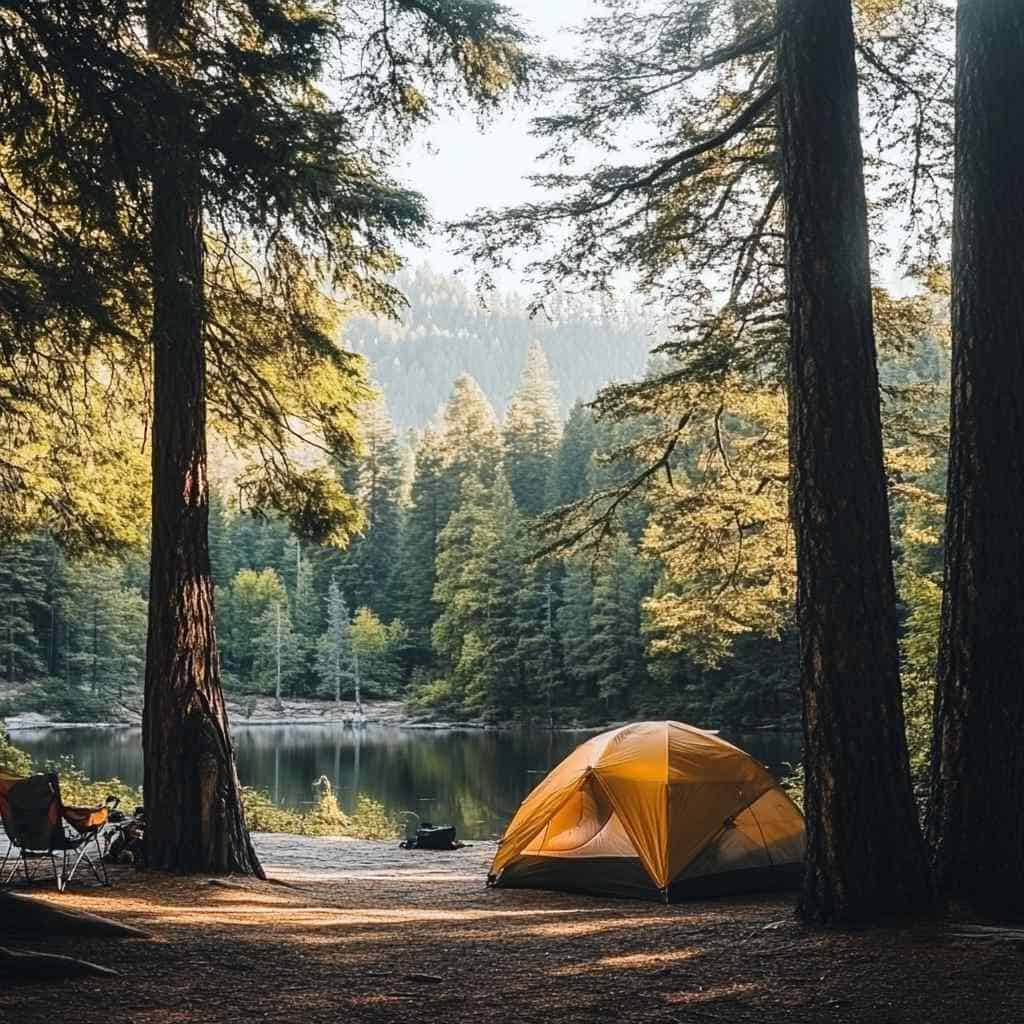
Alright, fellow campers, we’ve covered a lot of ground here. But I know from experience how easy it is to get overwhelmed when you’re staring at rows of gear in the outdoor store, or scrolling through endless options online.
So, let me break it down for you with a quick shopping list of camping essentials:
- A sturdy camping tent (your home away from home)
- Sleeping bag and camp bed or sleeping pad (for sweet dreams under the stars)
- Camping cooking equipment (to channel your inner wilderness chef)
- Camp stoves (because hot food = happy campers)
- Water container and filtration system (stay hydrated, my friends)
- Lighting (headlamp, lantern, or both)
- First-aid kit (better safe than sorry)
- Navigation tools (map, compass, or GPS)
- Appropriate clothing and footwear (layer up!)
- Picnic table cloth (turns any log or rock into a dining table)
Remember, this is just a starting point. Customise your list based on your specific needs, the length of your trip, and where you’re heading.
And hey, don’t forget to check out the rest of this article for more detailed advice on each category. It’ll help you build your essential camping checklist. Happy shopping, and even happier camping!
Time to Hit the Trail: Your Adventure Awaits!
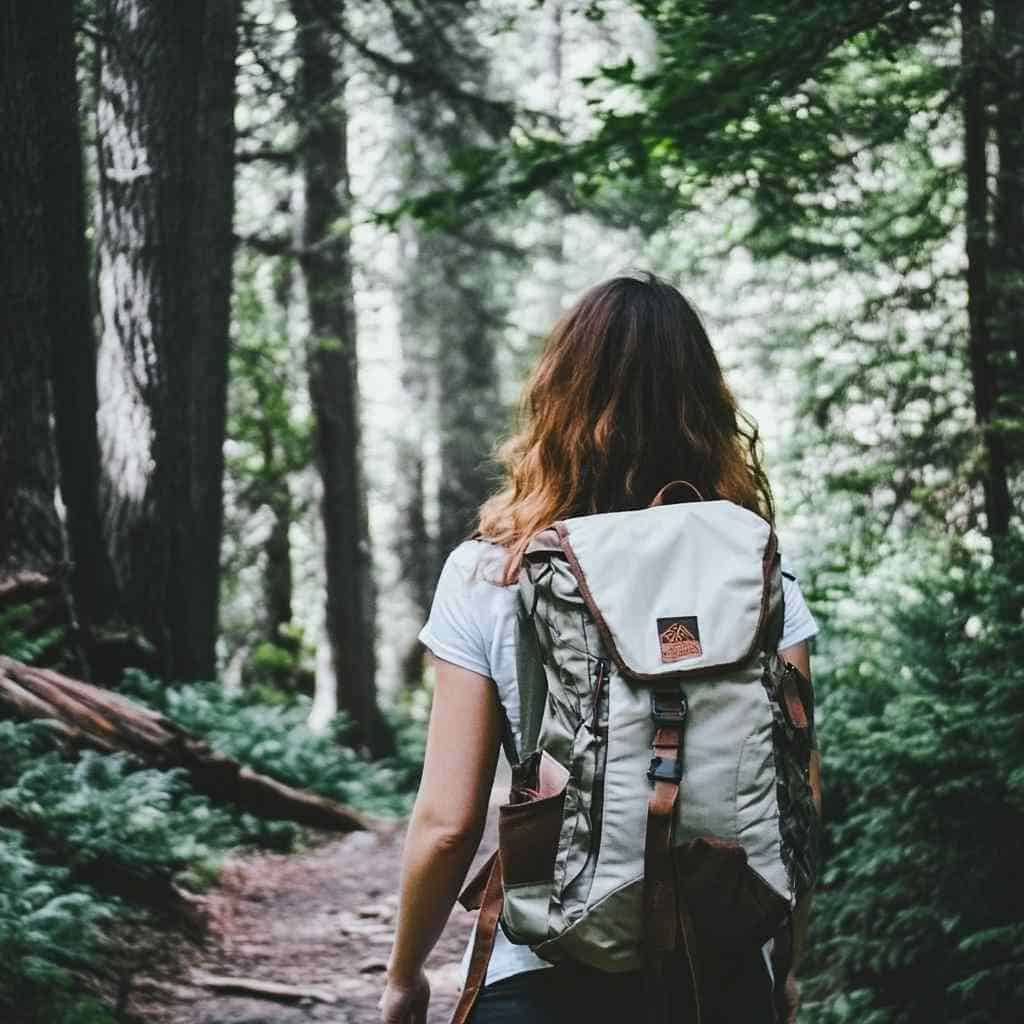
Whew! We’ve covered a lot of ground, haven’t we? From the essential gear that’ll keep you safe and comfortable, to the little luxuries that’ll make your trip extra special, and even how to minimise your impact on the great outdoors.
It’s a lot to take in, I know. But trust me, having a well-prepared camping gear checklist is like having a secret weapon for outdoor adventures.
Remember that time I told you about forgetting my can opener? Well, I haven’t made that mistake again. And that’s the beauty of a good checklist – you learn from your experiences and get better with every trip.
Now, here’s the thing – this list we’ve put together is comprehensive, but it’s not set in stone. Your perfect camping gear checklist might look a little different depending on where you’re going, what time of year it is, and what kind of camping you’re doing.
Are you car camping with the family or backpacking solo through the wilderness? Each trip might require a slightly different set of gear.
So, take this list and make it your own. Add to it, subtract from it, customise it to fit your needs. And most importantly, always, always check your gear before each trip. There’s nothing worse than getting to your campsite and realising your tent is missing a pole (yep, that’s another story for another day).
Before I leave, I want to remind you of something important: the best gear in the world doesn’t replace knowledge and experience. Learn how to use your gear properly. Practice setting up your tent in the backyard.
Learn how to read a map and compass. The more comfortable you are with your gear and skills, the more you’ll be able to relax and enjoy your time in nature.
And hey, I’d love to hear about your camping adventures! Got a must-have item that’s not on this list? A funny story about a camping mishap? Or maybe a beautiful spot you’d like to share?
Drop a comment below and let’s keep this conversation going. After all, the camping community is all about sharing knowledge and experiences.
So, what are you waiting for? Start packing, get out there, and make some memories. The great outdoors is calling, and now you’re more than ready to answer. Happy camping, everyone!
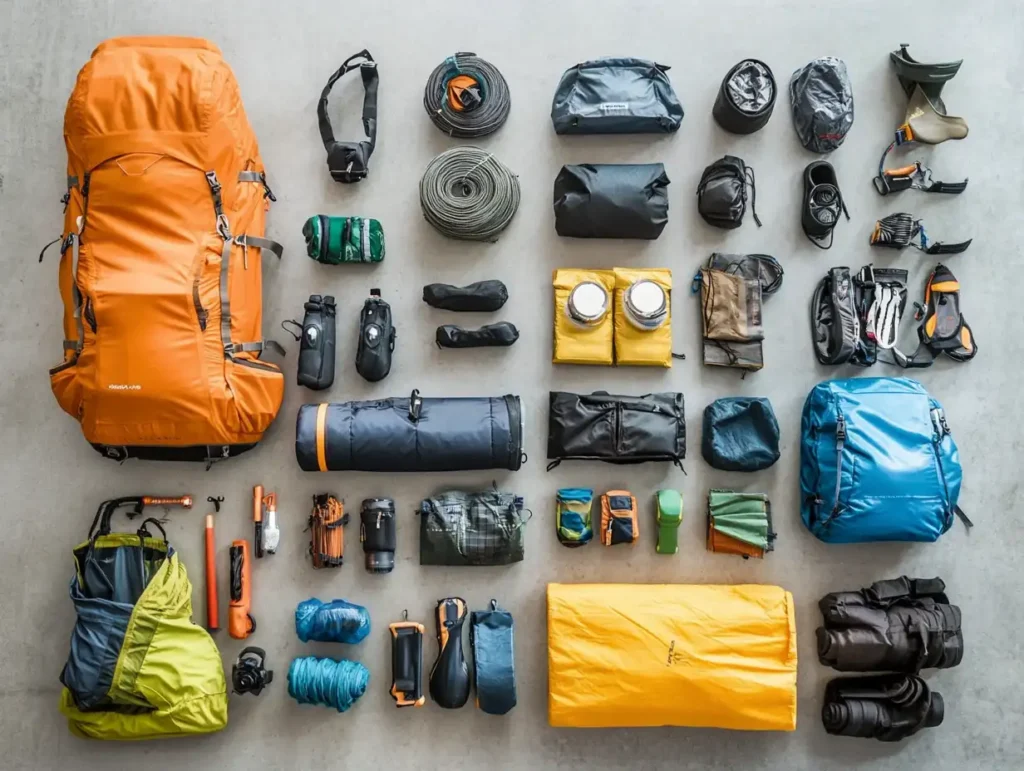
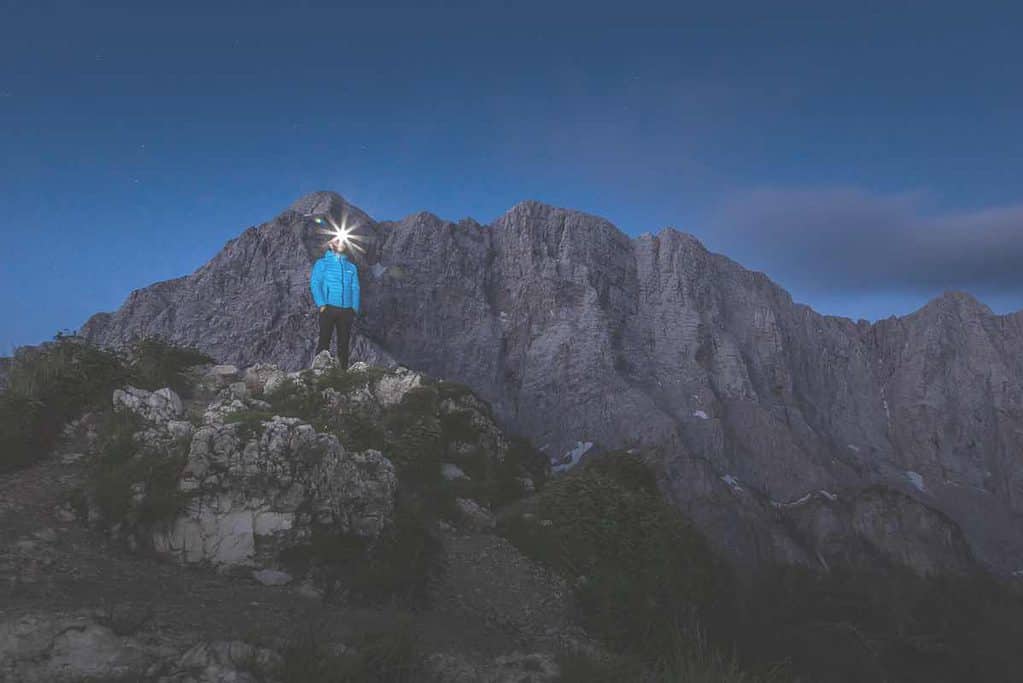
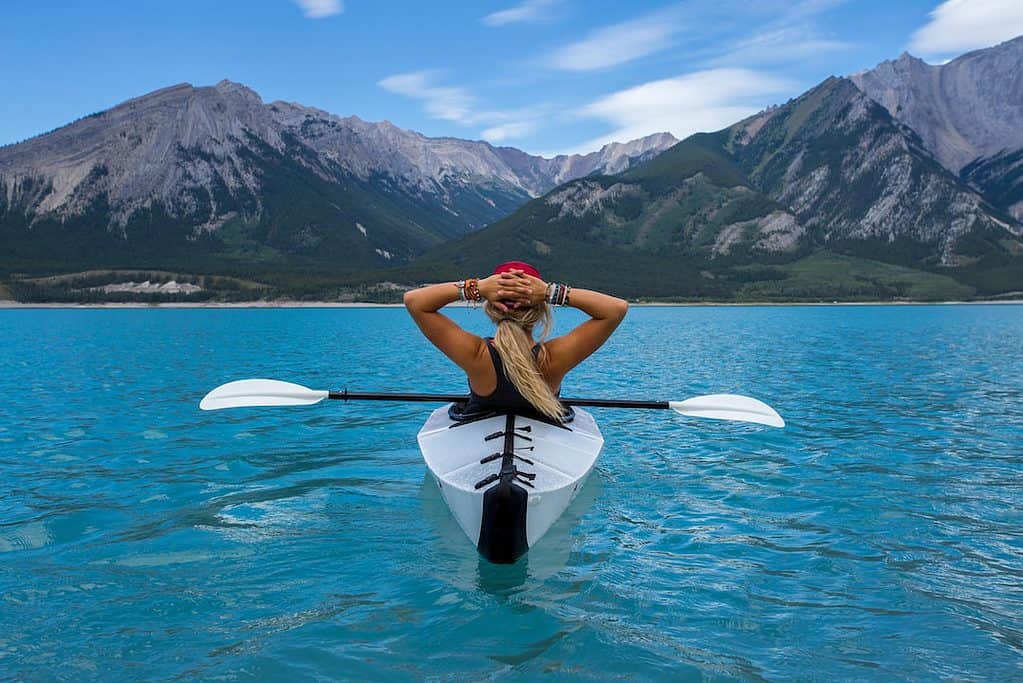
Pingback: What is the Best Jacket for Hiking? Find your Perfect Jacket
Pingback: Essential Camping Skills for Beginners: 2024 Guide
Pingback: Jetboil Mini Mo: Safe, Simple & Superb [2024 Review]
Pingback: Campfire Cooking Recipes: Guide to Outdoor Cooking | WBH
Pingback: 75 Hiking Tips for Beginners (for 2024)